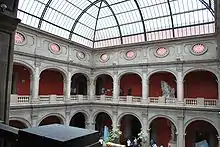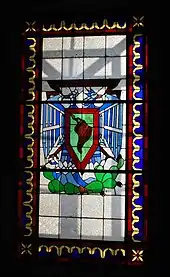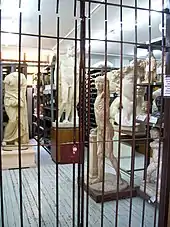Academy of San Carlos
The Academy of San Carlos (Spanish: Academia de San Carlos) is located at 22 Academia Street in just northeast of the main plaza of Mexico City. It was the first major art academy and the first art museum in the Americas. It was founded in 1781 as the School of Engraving and moved to the Academia Street location about 10 years later. It emphasized classical European training until the early 20th century, when it shifted to a more modern perspective. At this time, it also integrated with the National Autonomous University of Mexico, eventually becoming the Faculty of Arts and Design, which is based in Xochimilco. Currently, only graduate courses of the modern school are given in the original academy building.[1][2]
| Academy of San Carlos | |
|---|---|
 Academy of San Carlos on Academia Street | |

| |
| General information | |
| Location | Mexico City, Mexico |
History



The Academy of San Carlos was founded in 1783, being the first arts academy established in America in 1783, with European teachers, and bright students. In 1540 the building was built in order to create the first hospital for people with syphilis. Its name was "Hospital del Amor de Dios", and was closed in 1783 in order to fuse itself with the hospital of San Andrés in the old college of Jesuits on Tacuba street.[3]
Jerónimo Antonio Gil, a famous engraver, established in 1778 an engraving school by the order of King Carlos VI. It was so successful that with his partner, Fernando José Mangino, decided to create a new academy that teaches painting, sculpture and architecture. Finally, in 1781 classes started on the Real Casa de Moneda thanks to the donations of rich people, churches, the Tribunal of Trade and the states of Veracruz, Queretaro, Guanajuato, Cordoba and Orizaba.
The school's first director, Italian Jeronimo Antonio Gil, was appointed by Carlos III and gathered prominent artists of the day including José de Alcíbar, Santiago Sandoval, Juan Sáenz, Manuel Tolsá and Rafael Ximeno y Planes. Tolsá and Ximeno would later stay on to become directors of the school. The new school began to promote Neoclassicism, focusing on Greek and Roman art and architecture, advocating European-style training of its artists.[1] To this end, plaster casts of classic Greek and Roman statues were brought to Mexico from Europe for students to study.[2]
The Royal Card of establishment was issued on December 25 of 1783. It was asked by the viceroy Martín de Mayorga to the King Carlos III. They choose San Carlos as patron saint.

On November 4 of 1785, courses were officially started in the Academy of the Noble Arts of San Carlos of the New Spain. In 1788, the Academy of San Fernando in Spain sent some teachers like the famous Manuel Tolsá who was in charge of architecture and sculpture. Aspirations of growing up were so big, that they even tried to afford the building that Tolsá was designing on Nilpantongo Street, but it was way too expensive and it was paid by the Royal Seminar of Mining. Without a building of their own, the Academy asked for the forsaken one of the Hospital Amor de Dios and finally in 1787 they started classes there. Since its founding, it attracted the country's best artists, and was a force behind the abandonment of the Baroque style in Mexico, which had already gone out-of-fashion in Europe.[1]
In the early 19th century, the academy was closed for a short time due to the Mexican War of Independence. When it reopened, it was renamed the National Academy of San Carlos and enjoyed the new government's preference for Neoclassicism, as it considered the Baroque reminiscent of colonialism. Despite the school's association with the independent Mexican government, Emperor Maximilian I (installed in Mexico by the French) protected the school during his reign, although foreign artists were shunned there. When Benito Juárez ousted the emperor and regained the presidency of Mexico, he was reluctant to support the school and its European influence, which he considered to be a vestige of colonialism.[2]
The academy continued to advocate classic, European-style training of its artists until 1913. In that year, a student and teacher strike advocating a more modern approach ousted director Antonio Rivas Mercado. It was also partially integrated into University of Mexico (now UNAM) at that time, although it initially kept a large degree of autonomy. In 1929, the architecture program was separated from the rest of the academy,[1] and in 1953, this department was moved to the newly built campus of UNAM in the south of the city. The remaining programs in painting, sculpture and engraving were renamed National School of Expressive Arts Escuela Nacional de Artes Plásticas. Later, the undergraduate fine arts programs were moved to a facility in Xochimilco, leaving only some graduate programs in the original Academy of San Carlos building.[2]
Alumni and associated artists
Some of its most famous first teachers included Miguel Constanzó in architecture, José Joaquín Fabregat in metal engraving, Rafael Ximeno y Planes in painting and Manuel Tolsá in sculpture. Another notable teacher here was Pelegrí Clavé, who was noted for his expertise in creating portraits of heroes and biblical figures.[2]
Catalan Antonio Fabres was a dominant force at the Academy during the early 20th century. He would mentor later Mexican artists such as Saturnino Herrán, Roberto Montenegro, Diego Rivera and José Clemente Orozco.[2]
José María Velasco is considered the greatest artist associated with the Academy, famous for his landscapes of the Valley of Mexico and a mentor of Diego Rivera. Other artists linked to the Academy are Manuel Rodríguez Lozano, Alfredo Zalce, Andrés José López, José Chávez Morado, Francisco Moreno Capdevila, Luis Sahagún Cortés, Gabriel Fernández Ledesma, Roberto de la Selva and Jorge Figueroa Acosta.[2] Matusha Corkidi studied at the Academy after emigrating from Egypt.[4]
Mexican muralist Elena Huerta Muzquiz and her daughter Electa Arenal, both attended the school.[5][6][7]
Architects

A number of important nineteenth-century architects studied at the Academy, including Juan (b. 1825) and Ramón Agea (b. 1828), who were sent to Rome by the Academy to study with Cippolla. They sent back sketches of Roman monuments that served as models for Academy students. They went on to be professors at the Academy as well as working architects in Mexico City. They completed the Monument to Cuauhtémoc on Paseo de la Reforma after the death of the engineer in charge.[8] Another notable graduate (1863) is architect Manuel Francisco Álvarez, who was also a civil engineer. Álvarez was a city counsellor (regidor) of the capital, president of the Asociación de Ingenieros y Arquitectos, a founding member of the Asociación Francesa para el Desarrollo de la Enseñanza Técnica, Industrial y Comercial; director of the Escuela Nacional de Artes y Oficios; and a member of the Academy of France, and author of many books on architecture.[9]
Building


The building originally was as the Amor de Dios Hospital, which had closed by the time the School of Engraving decided to move there from the mint building. Founding director Gerónimo Antonio Gil took charge of the restoration and remodeling work. Artist Javier Cavallari created the Academy's Neoclassic facade, which is embellished with six medallions. Four of these represent the Academy's founders: Carlos III, Carlos IV, Gerónimo Antonio Gil and Fernando José Manguino, and the other two are of Michelangelo and Raphael. Cavallari also finished the patio, the conference room and the painting and sculpture galleries. The painting gallery contains portraits by Ramon Sagredo and the sculpture room contains works by José Obregón and Manuel Ocaranza.[2]
A number of plaster casts of classic statues from the San Fernando Fine Arts Academy in Spain were brought here for teaching purposes. These casts still exist and can be seen on display in the Academy's central patio. Some of these statues include casts of statues from the Medici tombs, Moses by Michelangelo, The Victory of Samothrace and Venus de Milo.[2]
Gallery
The academy once had a very large collection of art in the Gallery of the San Carlos Academy, considered the first museum of art in the Americas.[10] Its art collection began with plaster casts of original Greek, Roman and European works used as teaching aids. It also gained other European works such as engravings from the 16th to 19th centuries from Spain, France, England, Italy, Germany, and Holland. The school also collected works from students and teachers from its founding to beginning of the 20th century. However, the collection outgrew the original academy building as it received donations from private sources and purchases made by the Mexican government after independence. The collection was divided, some going to the Museo Universitario de la Academia, also in the historic center of town, some going to the National Museum of San Carlos, northeast of the historic center and the other part remaining in the original building.[10][11]
See also
References
- "Academia de San Carlos" (in Spanish). Archived from the original on 2009-04-09. Retrieved 2009-03-30.
- Galindo, Carmen; Magdelena Galindo (2002). Mexico City Historic Center. Mexico City: Ediciones Nueva Guia. pp. 70–72. ISBN 968-5437-29-7.
- Covarrubias, Solís; José, Manuel (2009) Galerías de la Antigua Academia de San Carlos: pasado y presente. Memoria de restauración 2000-2007. Ciudad de México: UNAM. Dirección General del Patrimonio Universitario, Escuela Nacional de Artes Plásticas. ISBN 978-607-02-1099-0.
- Jules Heller; Nancy G. Heller (19 December 2013). North American Women Artists of the Twentieth Century: A Biographical Dictionary. Routledge. ISBN 978-1-135-63882-5.
- Francisco Tobías (May 20, 2013). "Elena Huerta". Zocalo. Saltillo. Retrieved June 23, 2015.
- Guillermina U. Guadarrama Peña. "Pese a todo... Elena Huerta fue muralista Crónicas". Crónicas. UNAM. Retrieved June 23, 2015.
- Heller, Jules; Heller, Nancy G. (2013). North American Women Artists of the Twentieth Century: A Biographical Dictionary. Routledge. ISBN 9781135638894.
- Israel Katzman, Arquitectura del siglo XIX en México. tomo 1. Mexico: Centro de Investigaciones arquitectónicas. Universidad Nacional Autónoma de México 1973, p.266.
- Katzman,Arquitectura del siglo XIX en México p. 267
- "Nacional Museum of San Carlos". Archived from the original on 2008-12-03. Retrieved 2009-03-29.
- "Academia San Carlos, Mexico City". Archived from the original on 3 May 2009. Retrieved 2009-03-30.
Further reading
- Charlot, Jean. Mexican Art and the Academy of San Carlos, 1785-1915. Austin: University of Texas Press 1962
External links
| Wikimedia Commons has media related to Academy of San Carlos, Mexico City. |
